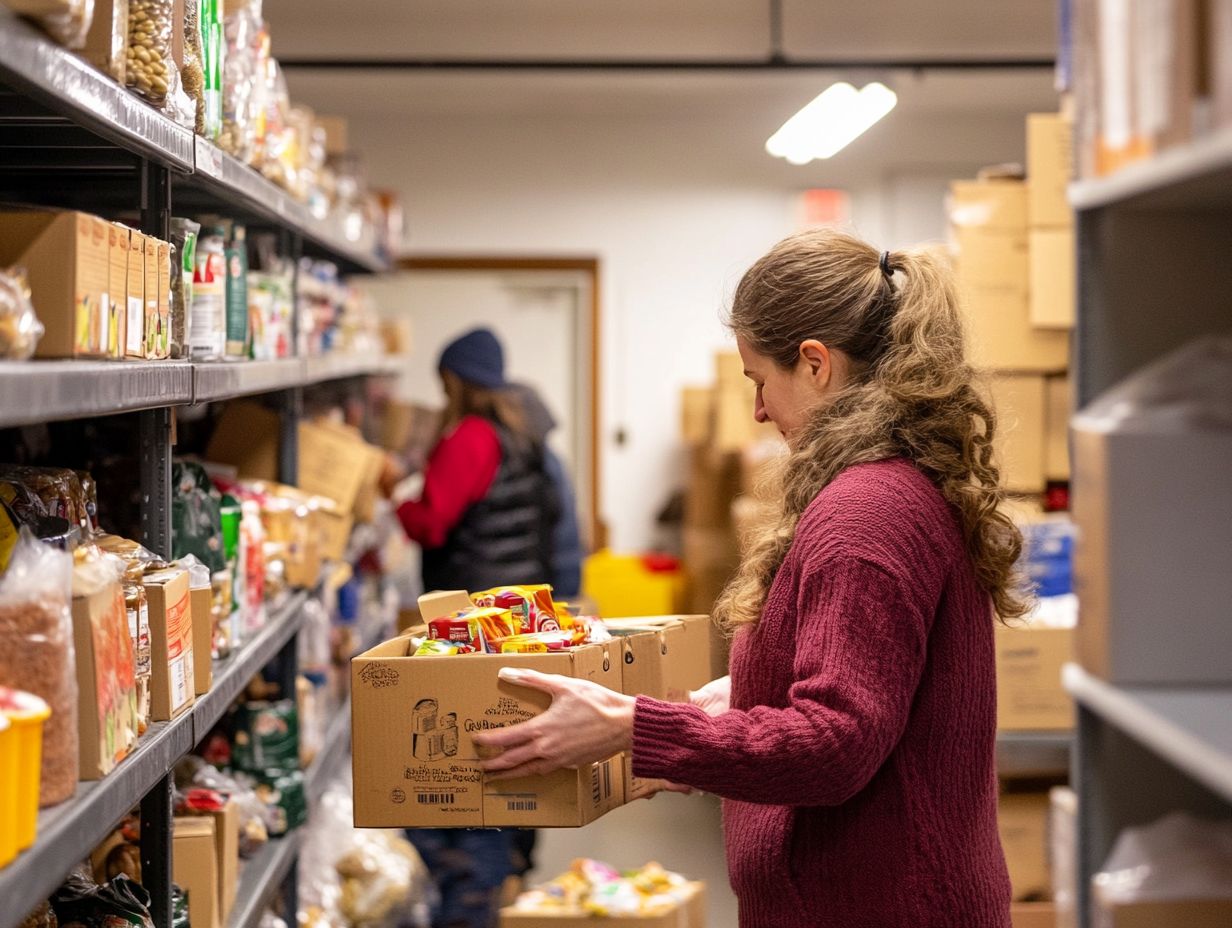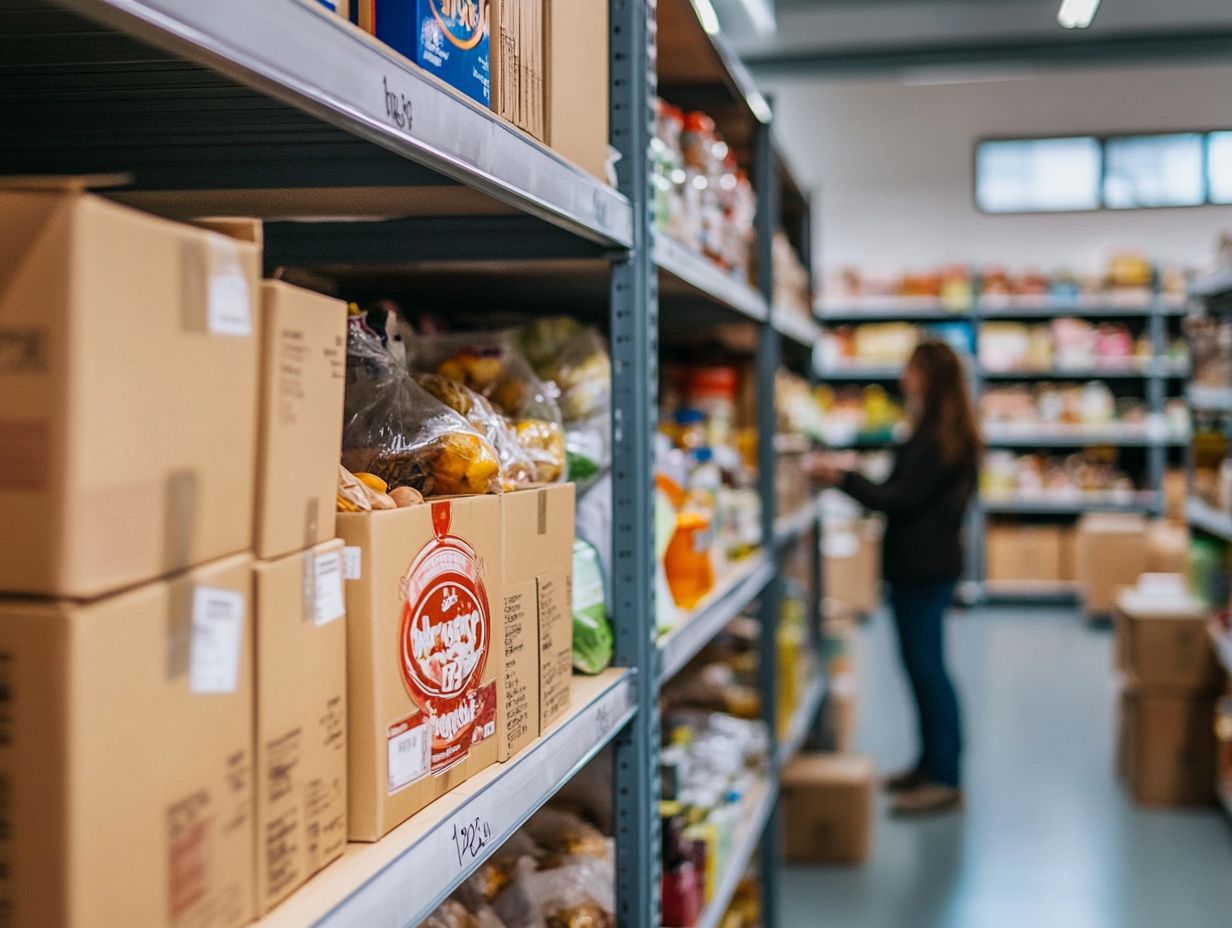Hunger remains a pressing issue that affects communities across the globe, often lurking in plain sight, particularly in food deserts. Local food banks and pantries, such as the Arkansas Foodbank and Los Angeles Regional Food Bank, serve a crucial role in addressing this challenge, offering essential assistance to those in need.
This article delves into the inner workings of food banks, examines the profound impact of food insecurity, and highlights the ways individuals can make a difference through donations, volunteering, and engaging in community programs.
By engaging in this crucial fight against hunger, whether through volunteer opportunities or financial donors, one can discover how their contributions can create a lasting impact within their community.
Key Takeaways:
Understanding Food Banks and Pantries

Food banks and pantries function as essential lifelines for individuals and families grappling with food insecurity, delivering crucial food resources and nutritious meals to those in need.
Generally, food banks operate as wholesale distributors, procuring food from a variety of partners, including local grocery stores and government programs such as SNAP. In contrast, food pantries serve as the frontline facilities, providing families with direct access to these vital resources within their communities.
What is a Food Bank?
Food banks like those operated by nonprofit organizations such as The Salvation Army are crucial in hunger relief efforts.
A food bank serves as a centralized hub for the collection, storage, and distribution of food to partner agencies, including food pantries, soup kitchens, and shelters, thereby playing an essential role in hunger relief initiatives.
These nonprofit organizations depend on contributions from individuals, local grocery stores, and government programs such as SNAP to supply nutritious food and vital resources to those facing food insecurity.
Their operations are characterized by systematic protocols for food acquisition, often fostering partnerships with community organizations that share a mutual dedication to alleviating hunger.
By collaborating with local farms, businesses, and even educational institutions, these food banks ensure a diverse array of offerings that go beyond canned goods and dry staples, encompassing fresh produce, dairy, and protein sources.
Moreover, these facilities frequently implement educational programs designed to promote healthy eating habits among their beneficiaries, thereby enhancing their mission to combat malnutrition and cultivate a more resilient community.
In this manner, food banks emerge as a vital lifeline for countless individuals and families striving to navigate the challenges posed by food scarcity.
What is a Food Pantry?
Food pantries serve as local distribution hubs, offering immediate food assistance to individuals and families facing hardship, often through drive-through distributions. Often collaborating with food banks and community partners, these pantries provide access to nutritious meals, seasonal fruits, and essential household items, thereby alleviating hunger and addressing the nutritional needs of vulnerable populations within their communities.
These critical services act as a crucial safety net, ensuring that no one in the community faces hunger due to temporary financial difficulties. Typically, food pantries distribute a diverse array of items, including non-perishable goods such as canned items, pasta, and rice, alongside fresh produce, dairy products, and meats, catering to a wide range of dietary preferences and requirements.
Moreover, food pantries actively engage with local farms, grocery stores, and warehouses, forging strategic partnerships that enhance the variety and availability of food supplies. Along with food distribution, many pantries offer supplementary resources like nutrition education and cooking workshops, give the power toing recipients to make informed choices and maximize the utility of the food they receive.
How Do They Work Together?
Food banks and food pantries engage in a synergistic partnership, often as part of a larger partnership network, to establish an efficient food distribution system that effectively addresses hunger relief within local communities. Food banks take on the responsibility of procuring and storing substantial quantities of food, while food pantries leverage this supply to deliver meals to those in need, ensuring that essential resources reach households most affected by food insecurity.
This collaboration not only amplifies the impact of available resources but also promotes a community-centric approach to combating hunger. The logistics of this relationship are complex, as food banks meticulously coordinate delivery schedules and transportation to an array of pantries dispersed across various regions.
Food distribution strategies are carefully tailored to meet the unique needs of each community, often incorporating partnerships with local organizations and community centers that provide valuable insights into the demographics they serve. Such collaborations underscore the critical importance of community partners, whose local expertise enhances the efficiency of the food supply chain and plays a significant role in alleviating hunger among vulnerable populations.
Food Distribution: The Essentials
Food distribution efforts are supported by community engagement and volunteer networks, ensuring that nutritious food reaches those in need.
Effective food distribution stands as a cornerstone in the effort to ensure that vulnerable communities have access to the essential food resources necessary to combat hunger and sustain nutritional health, particularly in food deserts.
This endeavor requires a meticulously coordinated approach, involving food banks, mobile food pantries, volunteer networks, and partner agencies. Together, these entities work harmoniously to acquire, store, and distribute food with efficiency, reaching those who face the challenges of food insecurity.
Where Does the Food Come From?
The food distributed by food banks and pantries originates from a myriad of sources, including donations from local grocery stores, generous community members, and government programs like SNAP, which provides vital food resources to low-income families. Additional contributions come from food drives organized by community partners. These varied contributions ensure a continuous supply of nutritious food, allowing organizations to meet the increasing demand for hunger relief.
Along with these sources, strategic partnerships with food manufacturers and wholesalers are instrumental, enabling food banks to access surplus items that might otherwise be lost to waste. Local farmers frequently donate fresh produce, enriching the array of food options available to those in need.
Dedicated volunteers and community-driven campaigns play a pivotal role in raising awareness, motivating individuals to organize food drives that further enhance the inventory.
Collectively, these efforts establish a robust support system that fosters a profound sense of solidarity while tackling the pervasive issue of food insecurity within the community.
Types of Food Distributed

The array of food distributed by food banks and pantries is remarkably diverse, ranging from nutritious meals and seasonal fruits to essential household items such as toiletries and cleaning supplies. This variety is vital for ensuring that families not only receive the nourishment they require but also the support necessary to maintain a healthy lifestyle.
Many food banks prioritize offering fresh produce, canned goods, and frozen meals, all while adhering to nutritional guidelines designed to promote balanced diets. These organizations also cater to specific dietary needs, providing specialized items such as gluten-free or low-sodium options, thus facilitating access to nourishing meals for individuals with particular health considerations.
Seasonal availability significantly influences the offerings; autumn harvests yield a bounty of squash and greens, while the summer months bring forth an abundance of succulent berries and ripe tomatoes. Mobile food pantries often adapt to these seasonal changes to ensure fresh produce is available.
Additionally, pantries frequently organize community programs, such as those hosted by USC Dornsife, aimed at educating families about meal planning and preparing nutritious recipes, effectively bridging the gap between food access and healthy living.
The Impact of Food Insecurity
Understanding food insecurity is crucial for developing effective hunger assistance programs.
Food insecurity represents a pressing challenge that impacts millions of individuals and families nationwide, contributing to a hunger crisis that exerts significant pressure on communities.
Grasping the breadth of food insecurity is vital for effectively addressing community needs and delivering meaningful food assistance through local food banks and pantries, such as those supported by the United States Department of Agriculture (USDA).
Who Can Receive Assistance?
Individuals and families facing food insecurity have the opportunity to seek assistance from food banks and pantries, regardless of their background, income level, or specific circumstances. This includes accessing nutritional food through children’s nutrition programs. Numerous organizations also welcome SNAP and food stamp beneficiaries, enabling eligible households to access vital food resources and nutritious meals to support their families.
To qualify for assistance, applicants typically must demonstrate their current financial situation, which may involve furnishing documentation such as pay stubs, identification, or a statement of income. Each food bank may establish distinct eligibility criteria and application processes, often providing options for both online and in-person applications to enhance accessibility.
Importantly, those enrolled in SNAP or food stamp programs often receive priority, ensuring a more streamlined experience in obtaining essential supplies. Many pantries are also attentive to dietary restrictions, offering items that cater to diverse needs while promoting healthier eating habits.
Statistics on Food Insecurity
Statistics on food insecurity present a staggering reality, revealing that millions of Americans encounter daily struggles in accessing sufficient food and resources. This exacerbates the hunger crisis and underscores critical community needs. According to Feeding America, over 38 million individuals in the U.S. experienced food insecurity in the previous year, highlighting the urgent necessity of poverty alleviation efforts.
The ramifications of food insecurity extend well beyond the immediate experience of hunger; they profoundly impact physical health, educational outcomes, and overall well-being, especially among vulnerable populations such as children and the elderly.
Recent studies indicate that one in six children resides in food-insecure households, a situation that can precipitate developmental challenges and hinder academic achievement. Furthermore, marginalized communities, particularly racial and ethnic minorities, disproportionately feel the consequences of this pressing issue.
Addressing this crisis demands collective action from individuals, local organizations, and policymakers alike. Meaningful community involvement has the potential to alleviate these challenges significantly and promote a healthier, more equitable society.
How You Can Help
Individuals have a myriad of avenues to contribute to the noble fight against hunger, ranging from financial donations to actively participating in volunteer opportunities at local food banks and pantries.
Engaging in such community initiatives not only delivers essential food assistance to those in need but also cultivates a culture of compassion and solidarity within the community.
Ways to Donate
Donating to local food banks stands out as one of the most immediate and effective ways to bolster hunger relief efforts. There are numerous avenues available for contributions, whether they take the form of food items or financial support. Each dollar donated give the power tos food banks to acquire and distribute essential food resources to those in need.
Individuals and organizations may also consider in-kind contributions, which encompass non-perishable food items such as canned goods, pasta, or rice—each of which plays a pivotal role in adequately stocking food pantry shelves.
Engaging in food drives can further amplify the impact of these contributions, fostering community engagement while facilitating the collection of larger quantities of food.
Financial donations, regardless of their size, prove invaluable; they grant food banks the flexibility to address urgent needs promptly, enabling them to purchase fresh produce or specific items that are not commonly donated. Ultimately, every method of giving enriches the community and ensures that everyone has access to nutritious meals.
Volunteering Opportunities

Volunteering at local food banks and pantries provides individuals with a meaningful opportunity to effect change in the ongoing battle against food insecurity. Whether they are assisting with food distribution, organizing food drives, or managing administrative tasks, volunteers are integral to ensuring that essential food resources reach those in need.
Beyond these vital functions, volunteers can also engage in sorting and packing food items, interacting with clients to offer information and support, or even taking part in outreach initiatives aimed at raising awareness about local hunger issues. Each volunteer brings distinct skills and perspectives that enhance the overall efficiency and effectiveness of food distribution efforts.
The sense of belonging and community that arises from these shared experiences not only strengthens connections among volunteers but also deepens their understanding of the challenges faced by those experiencing food insecurity. By connecting with neighbors and local organizations, volunteers can magnify their impact, creating a ripple effect that inspires others to join the collective effort against hunger.
Advocacy and Raising Awareness
Advocacy and raising awareness about food insecurity are essential for mobilizing community resources and ensuring that those in need have access to food assistance programs. By utilizing the strength of social media, organizing community events, and implementing educational initiatives, individuals can significantly contribute to fostering a deeper understanding of the hunger crisis and its repercussions on local communities.
Engaging local leaders and organizations in discussions about hunger can amplify efforts to develop actionable solutions. Workshops and seminars can equip residents with the knowledge necessary to advocate for improved policies and more effective food systems.
Through strategic partnerships with local businesses, food drives and awareness campaigns can be organized, underscoring the importance of collective action. Establishing volunteer opportunities enables community members to engage directly, cultivating a sense of ownership and responsibility in addressing food insecurity.
These approaches not only enhance awareness but also give the power to individuals to take meaningful steps toward resolving the pressing issue at hand.
Get Involved with Your Local Food Bank
Engaging with the local food bank presents a compelling opportunity to make a meaningful impact in the fight against hunger at the grassroots level.
By participating in community engagement efforts, individuals can support vital food distribution initiatives, volunteer for food drives, and forge partnerships that significantly enhance the reach and effectiveness of local food assistance programs.
Finding Your Local Food Bank
Locating a local food bank represents the crucial first step in fostering a positive impact within the community, serving to connect those in need with essential food resources and assistance programs.
Platforms such as Feeding America offer valuable tools for individuals seeking to identify food banks and pantries in their vicinity, ensuring that no one confronts food insecurity in isolation.
Beyond online resources, reaching out to community organizations—such as churches, schools, and local non-profits—can yield significant insights into available food assistance.
Social media platforms frequently host local groups dedicated to disseminating food-related resources, making them another useful avenue for information. Additionally, community centers and bulletin boards often display flyers and announcements regarding upcoming food drives, further enhancing awareness.
Engaging with neighbors and local networks can foster relationships that facilitate support and resource-sharing, ultimately nurturing a more interconnected community committed to alleviating hunger.
Staying Informed: Subscribe for Updates
Staying informed about the local food bank’s activities and volunteer opportunities is crucial for maximizing community impact. By subscribing to newsletters and following social media channels, individuals can receive timely updates regarding food assistance programs, events, and avenues for contribution.
Active engagement with the food bank’s communications provides valuable insights into the specific needs within the community and the ongoing challenges faced by families seeking assistance. This heightened awareness fosters a deeper understanding of food insecurity and give the power tos supporters to tailor their donations and volunteer efforts to effectively address those needs.
Attending community meetings or outreach events can further illuminate the numerous ways locals can contribute and make a difference. Every small action holds significance, and maintaining this connection ensures that one’s contributions are both impactful and relevant.
Frequently Asked Questions
What is the purpose of donating to my local food bank?

By donating to your local food bank, you are helping to fight hunger in your community and providing food for those in need.
How does my donation directly impact my local community?
Donating to your local food bank ensures that the food stays within your community and is distributed to those who need it most.
Can I choose what food items to donate?
Yes, most food banks accept a variety of non-perishable food items. You can also check with your local food bank to see if they have a list of preferred items.
Can I donate money instead of food items?
Absolutely. Monetary donations are often preferred by food banks as they can use the funds to purchase fresh produce and other items that are in high demand.
How can I find my local food bank?
You can easily find your local food bank by searching online or checking with your city or county government. You can also ask for recommendations from friends, family, or local organizations.
Are donations to food banks tax-deductible?
Yes, donations made to a registered nonprofit food bank are typically tax-deductible. Be sure to keep your receipt for tax purposes.